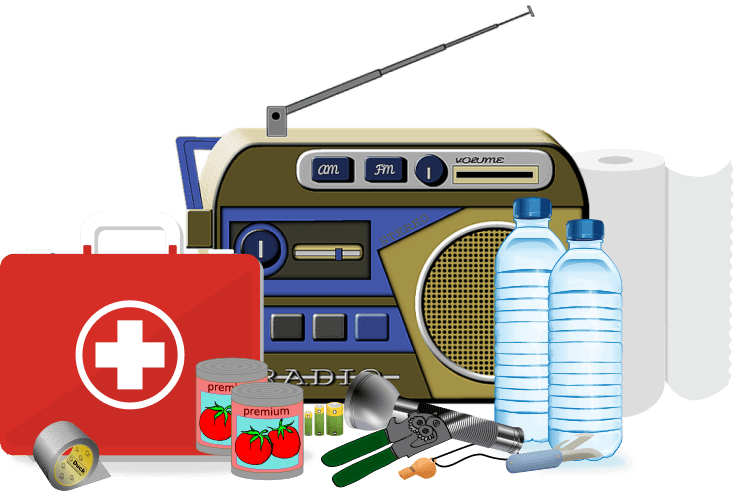

Last week we talked about the 3-3-3-1 rule for developing your emergency plans and how to create a Bug Out Bag for the first three minutes of a disaster. This week we're going to look at the three-day plan, the second 3 of the 3-3-3-1 rule.

Start with a plan
Based on the emergencies you are most likely going to face, develop a family emergency plan. Sit down with your family and discuss these questions:
After you develop your emergency plan, you should practice it so that everyone feels confident about what to do when an emergency strikes.
Now it’s time to build your kit
Now that you have an idea of what you are preparing for and what your plan is, it’s time to build your 72-hour kit. There are five components to your kit. Items marked with an asterisk (*) are things you probably already have in your house:
Food and water: You will want enough food for 2000-3000 calories/day and at least one liter of water*. This food can be in the form of high-energy bars, MRE's, freeze-dried foods or shelf-stable foods like canned soups and dinner mixes*. Include a mess kit and something to heat your food. Be sure to include formula if needed for infants. Multivitamins will help ensure you are getting what your body needs during a stressful time.
Light: Solar-powered or hand-crank flashlights* or lamps* are best. You can also use battery-powered flashlights or lamps. Just make sure you check the batteries regularly to make sure they are fully charged.
Warmth: You’ll want to be able to stay warm if your emergency occurs during winter months. You may want to include blankets*, hand and foot warmers, and extra socks*, gloves*, and hats*.
First Aid: Depending on the ages of family members and any unique medical needs, this can be anything from a simple, pocket-sized first aid kit with some aspirin and band-aids to a complete medical kit. Make your own or buy a ready-made kit. You should include any prescription medications that family members require as well as over-the-counter medications* you commonly use.
Hygiene and Comfort: You’ll want to stay clean and comfortable during the stress of a crisis. You should have toilet paper*, hand wipes, and soap* (hand soap, travel-size shampoo, and dish soap). Don’t forget a toothbrush* and toothpaste*. Include a couple plastic grocery bags for garbage and dirty clothes. You might put one of those plastic bags around a roll of toilet paper to keep it clean and dry. Include a change of clothes, underwear, and socks*; as well as games, pen/pencil*, and notepaper*. You should have an eyeglass repair kit if anyone in the family wears glasses. Be sure to include important information such as copies of house and medical insurance* and important phone numbers.

Storing the kits
The easiest way to store your kits is to have a backpack for each family member. If children are not old enough to carry a backpack, combine the contents of their kits with older siblings or parents. If you have a lot of young children, you may just want to put everything into one plastic storage tote.
Store the kits in a closet by the door or in the garage, somewhere where you can easily grab them when evacuating. If you store the kits in a garage, make sure that the contents will not be damaged by freezing temperatures.
Make a list and set a budget
Go through your house to see how much of your kits you can construct with what you already have on hand.
Now make a list of anything else that you need for your kits and set a budget of how much you can spend each week. Hopefully this is something you'll never need to use, so don't let it break the budget. Start by shopping at the dollar store, thrift store, and garage sales.
Keep this shopping list with you so that when you run across rummage sales or sales in the stores, you know what you still need to get. Each week, buy as much as your budget will allow. Store your purchases in the designated backpacks or storage bin.
Are your kits really complete?
Just like you did with your Bug Out Bags, once you assemble your 72-hour kits, it’s time for a practice run. This is like a fire drill. Everyone should put the plan into action, grabbing their kit and going to the designated meeting place. This is a mock 3-day emergency condensed into a couple hours. You want to know that everyone knows how to use the contents of the bag and see if you are missing any vital ingredients.
You've made a plan, gotten your supplies together, and practiced your plan. You’ve taken all the important steps to be ready for an emergency. You can rest easier knowing your family has made so much progress towards being prepared.
Free worksheet for developing your family's emergency plan:
https://www.providenthomecompanion.com/product/create-your-family-emergency-plan/
More tips for making your 72-hour kits: https://www.providenthomecompanion.com/tips-and-tricks-for-72-hour-kits/